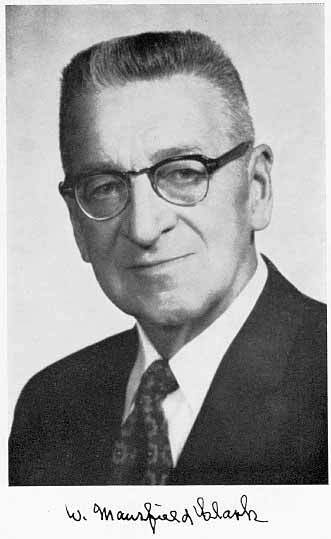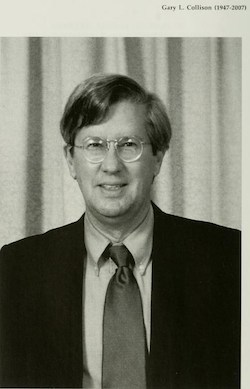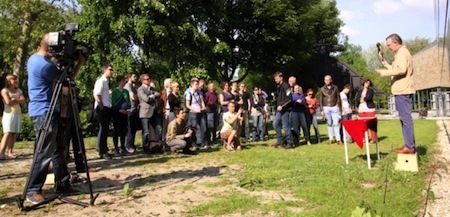Marc Abrahams's Blog, page 485
June 17, 2013
Extraocular Phototransduction: more than meets the eye? (part 1)
 If you are unlucky enough to be suffering from the debilitating effects of long-haul jet-lag, you could try shining a very bright light into your popliteal fossae (the backs of your knees). The potential of this technique as a way of shifting the phase of one’s circadian clock was first described by professors Scott S. Campbell, PhD and Patricia J. Murphy, PhD of the Laboratory of Human Chronobiology, at Cornell University Medical College, NY, US, in their paper for Science, 16 January 1998: Vol. 279 no. 5349 pp. 396-399 Extraocular Circadian Phototransduction in Humans.
If you are unlucky enough to be suffering from the debilitating effects of long-haul jet-lag, you could try shining a very bright light into your popliteal fossae (the backs of your knees). The potential of this technique as a way of shifting the phase of one’s circadian clock was first described by professors Scott S. Campbell, PhD and Patricia J. Murphy, PhD of the Laboratory of Human Chronobiology, at Cornell University Medical College, NY, US, in their paper for Science, 16 January 1998: Vol. 279 no. 5349 pp. 396-399 Extraocular Circadian Phototransduction in Humans.
In a set of laboratory experiments the team used a BiliBlanket Plus (Ohmeda) to illuminate the back of participants’ knees for several hours over several days – showing measurable effects on the phase of their biorhythms (though by a mechanism that is yet to be fully explained).
“Our results challenge the widely held belief that mammals are incapable of extraocular circadian phototransduction. The overall temporal profile, as well as the magnitude of the phase shifts achieved with our extraocular light stimulus, is similar to those reported by investigators who used single-pulse, full-spectrum light stimuli presented to the eyes“
The professors’ discoveries were capitalised with a patent (granted in 2000) Non-ocular circadian clock resetting in humans.
NOTE: Just two months later, another US patent was issued (this time to Seki et al.) which incorporated a knee-light in an aircraft-seat for in-flight jet-lag remediation. (From which the illustration above is taken)
COMING SOON : ‘Extraocular Phototransduction: more than meets the eye? (part 2)’


June 16, 2013
One crappy and two good ways to explore the universe
Of the many ways to explore the universe, there are some we can recommend, and one we do not.
1. Here’s a way we do NOT recommend:
2. Here’s one we do recommend. Corey Powell describes it as “The Most Amazing Map You’ll See Today (No Matter What Day It Is)“. It’s a 17-minute video with the slightly offputting title “Cosmography of the Local Universe“. Do not be offput. Powell further describes is at “the most amazing, three-dimensional map of the universe ever created”:
3. When you’ve seen ”Cosmography of the Local Universe“, and gotten a feel for the depths of the universe, you might want to spend the next few minutes, months, or years choosing to go pretty much wherever you like in the universe, zooming in, almost anywhere, for as much further detail as you can stand. Do that by using the WorldWide Telescope. (Thanks to Alyssa Goodman for bringing it to our attention.) In this TED Talk introduction, Roy Gould makes the modest suggestion that you explore the nooks and crannies of the universe:


June 15, 2013
The hazard of being an English football league manager
Sports managers, the ones who operate at the highest levels, don’t manage to hang on to their jobs long, says this study:
“The hazard of being an English football league manager: empirical estimates for three recent league seasons,” R. Bachan, Barry Reilly, and Robert Witt [pictured here], Journal of the Operational Research Society, vol. 59, no. 7, 2008, pp. 884-91. The authors report:
“This paper uses data drawn from the English Football League to model separate hazard rates for club managers for the 2001/2, 2002/3 and 2003/4 seasons. On average over the three seasons, approximately one-third of managers involuntarily exited employment status with their club. We model the hazard using a standard logistic model exploiting information on the spell at risk rather than the individual. The role of neglected heterogeneity is also examined using random and fixed effects logistic models within a discrete-time setting. League position at the start of the spell at risk is found to be the most important determinant of a manager’s involuntary exit. A variety of individual specific human capital and other covariates are found to be unimportant in determining the hazard and no role for unobservable heterogeneity as captured by random effects is detected.”

June 14, 2013
Two Underwear Theses in North Carolina
North Carolina is a world leader in producing student theses about underwear. Here are two. [The first might be summarized by saying: "Witness the fitness of His work"]
“Sizing and Fit of Men’s Underwear,” Taihesia Altovise Ross, master’s degree thesis, North Carolina State University, 2005.
The author begins by saying: ”Although my name is attached to this thesis I must admit that God has been the true author; because every word, table and figure have only been made possible through Him.”
She finishes with these words: ”Of the 67% of respondents that were dissatisfied with underpants, most (35%) wore a size large.”
and
“Exploring the decision-making process of men’s branded underwear consumers,” Rosanna Shouli, master’s degree thesis, University of North Carolina at Greensboro, 2007. The author reports:
“The purpose of this paper is to explore the role of involvement, brand loyalty, and gender in the purchase of men’s branded underwear… interviews were conducted with fifteen department store shoppers… The majority of participants were either high involvement/brand loyal, or low involvement/not loyal.”

Foghorn Requiem in the North Sea, on June 22
“The mournful sound of a foghorn is a product of the landscape through which it travels, but up close the foghorn is probably the loudest, most exciting sound you will ever hear.“
If you happen to be near Tyneside, in the NorthEast of England on June 22nd at around 12.30, you have a chance to hear the mournful, yet exciting sound of the Souter Lighthouse Foghorn – possibly for the last time accompanied by 75 musicians playing a work by composer Orlando Gough. And backed up by the horns, hooters and sirens of (at least) 50 ships moored offshore.
The event is free. Full details here.
NOTES :
[1] “The event is weather dependent.”
[2] Composer Orlando Gough also composed the music for the recent Queen’s Thames Diamond Jubilee Pageant. Sadly the Royal Barge ‘Gloriana’ crashed into a bridge yesterday – in good relatively good weather. [H.T. M.K.]

That’s Tripe, they emphasize or suggest
The Tripe Marketing Board wants to inform, tell, persuade or suggest to you, or to someone, that:
“The Tripe Marketing Board was set up in 1992 to replace The Tripe Council when its CEO, Paul Mellor, left to pursue a solo career. The Tripe Council was originally known as The Tripe Industry Development Council and, briefly, the British Tripe Council. Before that it was known as The Association For The Legal Disposal Of Unwanted Cow Products.”
BONUS: The two conflicting meanings of the word “tripe”, according to some or other dictionary:
1. The rubbery lining of the stomach of cattle or other ruminants, used as food.
2. Informal Something of no value; rubbish.
In the view of the Tripe Marketing Board, the second definition is not tripe, and very much is.
BONUS: The recording “Tripe fights back”:

What happened on Dead Duck Day 2013
Kees Moeliker prepared a full report, with photos, about what happened on Dead Duck Day 2013. Here’s the beginning:
Wednesday, June 5th 2013 was the 18th Dead Duck Day. At exactly 17:55h about 50 people gathered just outside the Natural History Museum in Rotterdam…. [read the entire report on Kees's blog]

Holes in Swiss Cheese – a century of investigation
 The formation of holes (a.k.a. ‘eyes’) in Swiss Cheese has been the focus of intense scientific scrutiny for more than a century. For a state-of-the art review of the literature – as it was around 100 years ago – see the work of William Mansfield Clark, [pictured right] late DeLamar professor of physiological chemistry at the Johns Hopkins University School of Medicine, who authored the landmark study On the Formation of “Eyes” in Emmental Cheese in 1917. (It was published in the post-inaugural second issue of the Journal of Dairy Science.) The professor concluded that the mysterious growth of large holes (rather than myriads of small ones) was akin to crystal formation, in that they appeared to be ‘seeded’.
The formation of holes (a.k.a. ‘eyes’) in Swiss Cheese has been the focus of intense scientific scrutiny for more than a century. For a state-of-the art review of the literature – as it was around 100 years ago – see the work of William Mansfield Clark, [pictured right] late DeLamar professor of physiological chemistry at the Johns Hopkins University School of Medicine, who authored the landmark study On the Formation of “Eyes” in Emmental Cheese in 1917. (It was published in the post-inaugural second issue of the Journal of Dairy Science.) The professor concluded that the mysterious growth of large holes (rather than myriads of small ones) was akin to crystal formation, in that they appeared to be ‘seeded’.
“There is really little reason, as well as little evidence, to support the assumption that the gas necessarily separates as gas bubbles where it is produced. It is not at all irrational to suppose that the gas, having first saturated the cheese mass, separates at advantageous points which have no necessary relation to those localities rich in bacterial growth. In other words we may suppose a process similar to the growth of crystals to take place.”
The lack of an exact description of the eye-forming mechanism provided impetus for future investigators of affinage. Since then, teams of cheese-bubble researchers across the globe have used Scanning Electron Microscopes, Computerised Image Analysis, X-rays, Ultrasound and even Nuclear Magnetic Resonance techniques to probe, measure, quantify and generally investigate the holes – with the objective of finally pinning down exactly how they form. For those keen to evaluate the latest progress, an entire chapter in the Technology of Cheesemaking (Second Edition) 2010, entitled ‘Eye Formation and Swiss-Type Cheeses’ is devoted to explaining the recent developments in the area. But comprehensive though the 22 page resumé certainly is, the authors point out that after all this time, enigmas still remain …
“A nucleus is necessary for the eye formation (Clark, 1917). It could be an air bubble attached to a solid curd particle, but the nucleation is not yet clearly understood.”
NOTES :
For cheese gourmets, holes can either add to, or detract from the attractiveness of cheese : Emmenthal is generally considered to be desirable if it has large ‘eyes’, Gruyère often has eyes too, but smaller, while others such as Beaufort are normally preferred ‘blind’.
FURTHER IMPROBABLE READING around the philosophy of holes in general :

How to intriguingly begin a story about a collision
This medical paper demonstrates how to intrigue the reader right away, in the first two sentences:
“Fracture penis: a case more heard about than seen in general surgical practice,” Manash Ranjan Sahoo, Anil Kumar Nayak, Tapan Kumar Nayak, Anand S, BMJ Case Reports, 2013.The authors, at SCB Medical College, Cuttack, Odisha, India, begin their report in compelling fashion:
“A 36-year-old man presented to the emergency department with a history of trauma to genitalia during intercourse. The patient reported the forceful collision between his penis and the bed and audible clicking sound with swollen penis thereafter.”

June 13, 2013
The Association for Graveyard Studies

Gary L. Collison, former editor of Markers, as pictured in the publication shortly after his decease.
The Association for Graveyard Studies takes a scholarly approach to graveyards and the contents thereof. Their official word on themselves:
The Association for Gravestone Studies (AGS) was founded in 1977 for the purpose of furthering the study and preservation of gravestones. AGS is an international organization with an interest in gravemarkers of all periods and styles.
An FAQ offers practical advice “for the newcomer to gravestone studies”, including “answers to basic questions about gravemarkers, such as, ‘Gravestone Rubbing Do’s and Don’ts’”. The web site describes a host of membership benefits. Our too-quick perusal failed to find discounts or other special offers pertaining to a member’s transition to permanent ownership of a grave or of a graveyard.
The members, many of them, produce reports. The Association lists several kinds:
Markers: Annual Journal of the Association for Gravestone Studies. Markers publishes definitive illustrated articles on cemetery and gravemarker topics as well as an extensive annual international bibliography of recent scholarship. (FREE to all members).
The AGS Quarterly: Bulletin of the Association for Gravestone Studies contains feature articles and regular columns on conservation, epitaphs, and international gravestone studies. (FREE to all members).
One can read many back issues of Markers, preserved above ground (metaphorically speaking) by the Internet Archive. In your wanders through the archives, should you discover some outstandingly improbable reports, we hope you will alert us, that we might alert others. Behold the logo of the The Association for Graveyard Studies:
(Thanks to investigator Dan Vergano for alerting us to the Association’s existence.)
BONUS: The Graveyard Book, by Neil Gaiman.
BONUS: “Killed by a coffin at Kensal Green Cemetary“

Marc Abrahams's Blog
- Marc Abrahams's profile
- 14 followers





